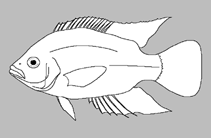Upload your photos and videos
Pictures | Google imageNo image available for this species;
drawing shows typical species in Cichlidae.
Pictures | Google imageNo image available for this species;
drawing shows typical species in Cichlidae.
Common names from other countries
Classification / Names Κοινά ονόματα | Συνώνυμα | Catalog of Fishes(Γένος, Είδη) | ITIS | CoL | WoRMS | Cloffa
> Cichliformes (Cichlids, convict blennies) > Cichlidae (Cichlids) > Pseudocrenilabrinae
Etymology: kumwera: The name kumwera means 'south' in Chichewa, alluding to the species' distribution in the southern part of Lake Malawi, and it is used as a noun in apposition (Ref. 119465).
Etymology: kumwera: The name kumwera means 'south' in Chichewa, alluding to the species' distribution in the southern part of Lake Malawi, and it is used as a noun in apposition (Ref. 119465).
Environment: milieu / climate zone / depth range / distribution range Οικολογία
; Γλυκού νερού βενθοπελαγικό. Tropical
Κατανομή Χώρες | Περιοχές FAO | Οικοσυστήματα | Παρουσίες | Point map | Εισαγωγές | Faunafri
Africa: Lake Malawi in Malawi (Ref. 119465).
Μέγεθος / Βάρος / Age
Short description Κλείδες προσδιορισμού | Μορφολογία | Μορφομετρία
Ραχιαίες άκανθες (συνολικά) : 17 - 19; Μαλακές ραχιαίες ακτίνες (συνολικά) : 8 - 10; Εδρικές άκανθες: 3; Μαλακές εδρικές ακτίνες: 7 - 8. Diagnosis: The steeply-sloped vomer without a swollen rostral tip, a small mouth, retrognathic jaws, and the presence of bicuspid teeth in the outer rows of the oral jaws and enlarged conical teeth at the back of the jaws place this species in Tropheops (Ref. 119465). Tropheops kumwera, body depth 23.6-31.0% of standard length, cannot reliably be distinguished from other Tropheops in body depth, 26.6-34.5% of standard length; it does have relatively smaller eye than other Tropheops, horizontal eye diameter 25.8-32.6% of head length and vertical eye diameter 24.2-31.4% of head length vs. 31.2-43.8% and 29.9-43.3% respectively, except T. kamtambo with 26.3-30.2% and 24.0-29.7% respectively (Ref. 119465). It can often be distinguished from T. kamtambo by a shallower head depth than in T. kamtambo, head depth 70.2-84.5% of head length vs. 79.4-97.1%; males of T. kumwera in territorial colour are distinguished from those of T. biriwira by their blue ground colouration and a blue dorsal fin, which are olive green/light blue and yellow-green in T. biriwira respectively; breeding male T. kumwera usually exhibit only the first 3-4 flank bars while male T. kamtambo exhibit all 9-10 bars; female T. kumwera lack a submarginal band in the dorsal fin which is present in female T. kamtambo (Ref. 119465).
Life cycle and mating behavior Γεννητική Ωρίμανση | Αναπαραγωγή | Γεννοβολία | Αβγά | Γονιμότητα | Προνύμφες
Main reference
Upload your references | Αναφορές | Συντονιστής : Kullander, Sven O. | Συνεργάτες
Li, S., A.F. Konings and J.R. Stauffer Jr., 2016. A revision of the Pseudotropheus elongatus species group (Teleostei: Cichlidae) with description of a new genus and seven new species. Zootaxa 4168(2):353-381. (Ref. 119465)
IUCN Red List Status (Ref. 130435: Version 2024-2)
Near Threatened (NT) (B1a+2a); Date assessed: 19 June 2018
Threat to humans
Harmless
Human uses
FAO(Publication : search) | FIRMS (Stock assessments) | FishSource |
Περισσότερες πληροφορίες
Trophic ecology
Τροφικά αντικείμενα
Σύσταση δίαιτας
Κατανάλωση τροφής
Food rations
Θηρευτές
Τροφικά αντικείμενα
Σύσταση δίαιτας
Κατανάλωση τροφής
Food rations
Θηρευτές
Ecology
Οικολογία
Home ranges
Οικολογία
Home ranges
Population dynamics
Παράμετροι Αύξησης
Max. ages / sizes
Length-weight rel.
Length-length rel.
Length-frequencies
Mass conversion
Στρατολόγηση
Αφθονία
Παράμετροι Αύξησης
Max. ages / sizes
Length-weight rel.
Length-length rel.
Length-frequencies
Mass conversion
Στρατολόγηση
Αφθονία
Life cycle
Αναπαραγωγή
Γεννητική Ωρίμανση
Γονιμότητα
Γεννοβολία
Spawning aggregations
Αβγά
Egg development
Προνύμφες
Δυναμική προνυμφών
Αναπαραγωγή
Γεννητική Ωρίμανση
Γονιμότητα
Γεννοβολία
Spawning aggregations
Αβγά
Egg development
Προνύμφες
Δυναμική προνυμφών
Anatomy
Επιφάνεια βραγχίων
Brain
Otolith
Επιφάνεια βραγχίων
Brain
Otolith
Physiology
Body composition
Nutrients
Κατανάλωση οξυγόνου
Κολυμβητικός τύπος
Ταχύτητα κολύμβησης
Visual pigments
Fish sound
Diseases & Parasites
Toxicity (LC50s)
Body composition
Nutrients
Κατανάλωση οξυγόνου
Κολυμβητικός τύπος
Ταχύτητα κολύμβησης
Visual pigments
Fish sound
Diseases & Parasites
Toxicity (LC50s)
Genetics
Γενετική
Heterozygosity
Κληρονομικότητα
Γενετική
Heterozygosity
Κληρονομικότητα
Human related
Aquaculture systems
Προφίλ υδατοκαλλιεργειών
Στελέχοι
Ciguatera cases
Stamps, coins, misc.
Aquaculture systems
Προφίλ υδατοκαλλιεργειών
Στελέχοι
Ciguatera cases
Stamps, coins, misc.
Εργαλεία
E-book | Οδηγός πεδίου | Ανάλυση κατά μήκος συνθέσεων | Εργαλείο ιστορίας ζωής | Σημειακός χάρτης | Classification Tree
| Catch-MSY |
Special reports
Download XML
Διαδικτυακές πηγές
Aquatic Commons | BHL | Cloffa | Websites from users | Check FishWatcher | CISTI | Catalog of Fishes(Γένος, Είδη) | DiscoverLife | ECOTOX | Faunafri | Fishtrace | GenBank(genome, nucleotide) | GloBI | GOBASE | | Google Books | Google Scholar | Google | IGFA World Record | MitoFish | Otolith Atlas of Taiwan Fishes | PubMed | Reef Life Survey | Scirus | SeaLifeBase | Δέντρο Ζωής | Wikipedia(Go, αναζήτηση) | World Records Freshwater Fishing | Zoobank | Zoological Record
Estimates based on models
Phylogenetic diversity index (Ref. 82804): PD50 = 0.5005 [Uniqueness, from 0.5 = low to 2.0 = high].
Bayesian length-weight: a=0.01000 (0.00244 - 0.04107), b=3.04 (2.81 - 3.27), in cm Total Length, based on all LWR estimates for this body shape (Ref. 93245).
Ελαστικότητα (Ref. 120179): Υψηλό, ελάχιστος χρόνος για διπλασιασμό πληθυσμού < 15 μήνες (Preliminary K or Fecundity.).
Fishing Vulnerability (Ref. 59153): Low vulnerability (10 of 100).




